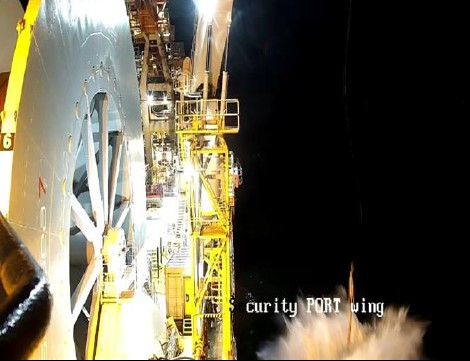Crane wire parted during offshore operations
What happened?
A concrete mattress was being deployed as part of the construction of a pipeline crossing. As the load was swung outboard and before it entered the water, the crane wire parted causing the load to fall to the seabed. The vessel was in a safe handling zone more than 5m from subsea assets. The mattress was overboarded when the crane was 17m from the nearest subsea asset.
The vessel’s main crane was being used to overboard a 6m x 3m x 0.5m concrete mattress, (15.8Te) + lifting frame (1.7Te). Mattress number 6 was deployed in a series of 15, as part of the crossing construction. The crossing was being built to allow a new pipeline to be laid which passed over a buried 3rd party gas pipeline.
During the lift, the load was swung outboard and before it entered the water, the crane wire parted causing the load to fall to the seabed. The mattress and lifting frame were found 6m away from the buried gas pipeline.


Findings – what went wrong
Procedures were not followed, and decisions were made without having the full facts or understanding of operations.
- The vessel main crane was in use during the period following the Magnetic Rope Testing (MRT) when the results were still being evaluated. The test results stated a clear recommendation to cut back the wire;
- The operational limit was set on using 30% of the crane capacity. There was a misunderstanding that the Safe Working Load (SWL) of the crane wire was 60Te;
- There was no process within the company’s Wire Rope Integrity Management Procedure that provided an option for application of an operational limit to deteriorating wires;
- No management of change process was applied to control the application and understanding of an operational limit, this may have triggered the involvement of the compny’s lifting experts ashore;
- No-one on the vessel questioned the operational limit, how it should be interpreted or how it applied to the crane load charts;
- There was no communication of the crane operational limits to the project team, subsequently this was not included in the worksite risk assessment review for the mobilisation and offshore operations.
Actions
- Ensure full communication and engagement between shore-side experts and management on the one hand, and vessel team on the other;
- Any dispensation for wire ropes should be recorded in planned maintenance systems;
- Ensure that mattresses are moved into position from a direction that prevents the mattress being lifted over existing pipelines;
- Reinforce the requirements for the consistent application of the management of change, and technical management of change.
Members may wish to refer to
Safety Event
Published: 17 March 2021
Download: IMCA SF 08/21
IMCA Safety Flashes
Submit a Report
IMCA Safety Flashes summarise key safety matters and incidents, allowing lessons to be more easily learnt for the benefit of all. The effectiveness of the IMCA Safety Flash system depends on Members sharing information and so avoiding repeat incidents. Please consider adding [email protected] to your internal distribution list for safety alerts or manually submitting information on incidents you consider may be relevant. All information is anonymised or sanitised, as appropriate.
IMCA’s store terms and conditions (https://www.imca-int.com/legal-notices/terms/) apply to all downloads from IMCA’s website, including this document.
IMCA makes every effort to ensure the accuracy and reliability of the data contained in the documents it publishes, but IMCA shall not be liable for any guidance and/or recommendation and/or statement herein contained. The information contained in this document does not fulfil or replace any individual’s or Member's legal, regulatory or other duties or obligations in respect of their operations. Individuals and Members remain solely responsible for the safe, lawful and proper conduct of their operations.
